Beethoven Reviews
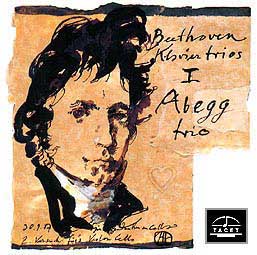 |
Ludwig van Beethoven |
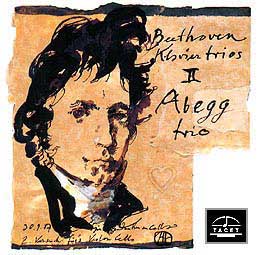 |
|
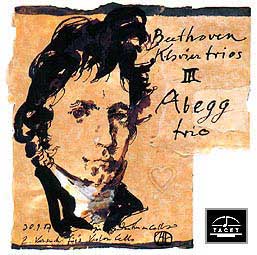 |
|
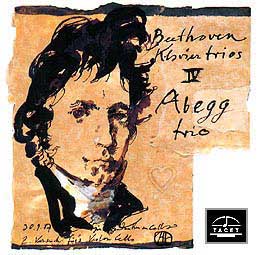 |
Ludwig van Beethoven |
Reviews
Classical
Voice of North Carolina
Embarking
on a Beethoven Journey with Germany's Abegg Trio
by John W.
Lambert
September
7, 2007, Chapel Hill, NC: One
summer, during high school, I worked for an expatriate German music
lover who lived on Long Island, NY. With help from his Pennsylvania
Dutch wife, Frank handled dogs for a living, visiting A.K.C.
championship shows. He also talked about — and listened to —
music as much as he could. There was plenty to hear in NY then, live
and on the radio, too; he had very few recordings because he didn't
need them. He was given to reminiscing, as people of a certain age
seemed, to these then-young ears, wont to do. In his homeland, as a
teenager, he had "collected" the Beethoven symphonies,
which he "amassed" by taking the train or in some cases
walking to various nearby towns and villages where rare live
performances were mounted. When he'd finally heard all nine, he felt
his young life was complete.
There
were some parallels for a teenager, growing up in NC at the time,
although we didn't walk from town to town for concerts. There was the
Met on the radio, and WPTF broadcast classical music on its new FM
station several times a week. We had some good choirs in the region
and our state orchestra and lots of college and university artists
(including UNC pianist and teacher William S. Newman) and amateurs,
too; there were concerts being offered by the Raleigh Chamber Music
Guild and the Chamber Arts Society; and some of the world's greatest
orchestras had begun appearing here, thanks to NC State's Friends of
the College Series.... Still, it was easy enough to identify with
Frank, and indeed it was years before we heard all
the Beethoven symphonies here or even all the concerti, for that
matter, and never mind all the violin sonatas or all the string
quartets. Back then, if you wanted to get to know
this music, you pretty much had to read
music or rely on records.
Little has
changed, although there's a lot less music in the public schools, and
fewer and fewer people can play music for themselves, except by
turning on the radio or putting on records or CDs. In addition, the
flood of outstanding visiting orchestras has dwindled to a paltry
trickle, leaving the field to mid-sized regional bands that seek to
catapult themselves to importance with unending marketing hype about
how great they are — or how great they want to be....
Through it
all, however, there were recordings, and many would agree that
reliance on them is not at all a bad thing. One can learn a lot by
listening, and one can become familiar with vast amounts of repertory
that way, thus preparing for those live performances that dot our
cultural landscape.
And
recordings can serve as calling cards for artists, too, helping them
introduce themselves and their art to the public. Thus it was, back
in 1999, while writing for Fanfare
(in large measure, in order to expand my personal library), that I
"discovered" the Abegg
Trio,
by means of their four CDs devoted to Beethoven's
piano trios.
These performances were revelations to me, thanks to the superior
sound quality of the recordings, the astonishing sonority of the
Bösendorfer piano used, the playing of these inspired and
inspiring artists, and their interpretations, graced but never
occluded by scholarship resulting from years and years of study and
performance together.
This
last bit may be among the Abegg Trio's most amazing and impressive
qualities: for 31 years, the ensemble has performed, mostly in
Europe, with never a change in personnel. As a result, the artists —
pianist Gerrit Zitterbart, violinist Ulrich Beetz (whose instrument
is by Nicholas Lupot, 1821), and cellist Birgit Erichson (Andrea
Castagnieri, 1747) — really do "play as one," to borrow a
phrase too often bandied about in connection with regional orchestral
string sections and the like. Toss in the Abegg Trio's members'
individual technical precision, their interpretive excellence, and
their long study of these scores, and you've got something truly
special. Beethoven's works have in a sense become the ensemble's
calling card, for they've played the individual trios numerous times
and given the entire cycle, in three or more substantial concerts, 27
times. (They also played these works all in the same
day — once — in their 25th
anniversary year!) And to state the obvious, if it hadn't been for
recordings — CDs — chances are we would never have heard the
Abegg Trio over here, in America, since we'd probably never have
heard of
them.
The
Abegg Trio's Beethoven CDs were so remarkable that I started trying
to interest chamber music presenters in bringing them to the United
States to perform the cycle. But in 1999, there were two major
obstacles: the closest Bösendorfer dealer was in Atlanta, too
remote to haul one in for a concert; and the artists didn't have US
management. They still don't, but their Canadian representative knows
the US ropes. And Richard
Ruggero
now represents Bösendorfer pianos in Raleigh.
When
the Abegg Trio performed here (and on the NC coast) the last time, in
the spring of 2005, our critics were enthusiastic,
so it was logical for the presenter, the Raleigh
Chamber Music Guild,
to seek a way to get them to come back to America. The die was cast
when Duke
Performances' Chamber Arts Society
and the UNC Music Department's William
S. Newman Artists Series
agreed to join forces with the Guild to present the Abegg Trio's
first full Beethoven cycle in America during the 2007 September
Prelude — the Triangle-wide event that marks the real start of the
season for chamber music enthusiasts in central North Carolina. (For
the record, the Abegg Trio's NC debut took place 20 years ago, at the
Reynolda House, in Winston-Salem.)
Thus it was
with keen anticipation that we entered UNC's Memorial Hall on the
evening of September 7 for the first of these three programs, offered
as part of the William S. Newman Artists Series (named in memory of
the aforementioned UNC pianist and scholar). On the stage was
Carolina Performing Arts' Hamburg Steinway, a fine instrument. (An
American Steinway was to be heard at Duke, and a glistening
Bösendorfer figured in the final concert, in Raleigh.) The bill
of fare in Chapel Hill was unusual in that all the works (including,
as it turned out, the encore) were in E-flat: the Variations, Op. 44;
the Piano Trios Nos. 1 (Op. 1/1) and 5 (Op. 70/2), and the
rarely-heard single-movement Triosatz, Hess 48.
Newman
Series coordinator and violinist Richard Luby offered welcoming
remarks, and the audience clearly sensed how special was the moment
as the artists came onto the stage, acknowledged the applause, and
sat down to begin. In a nutshell, the Abegg Trio delivered, in every
sense of the word, playing even more brilliantly and with even
stronger ensemble than on their recordings. They also observed every
sanctioned repeat, thus presenting Beethoven's music as it is not
always heard.
Now a lot of
water has gone over and through the dam since the Abegg Trio was last
in Raleigh, for the musicians have embraced even more than before the
"original instruments" movement, and they have made several
CDs using historic instruments. (In the mill, indeed, are new
recordings of all the Beethoven works for piano trio, including Op.
11 — in both clarinet and violin editions.) These forays into older
performance practice have, in turn, informed the ensemble's playing
on modern instruments, so the renditions heard in Chapel Hill were,
if anything, more refined and often clearer and more cleanly
articulated than on those CDs. This demonstrates once again a
paramount quality that distinguishes the Abegg Trio from many of its
peers: every time they take up a work, no matter how many times
they've played it, they go over it as if they were performing it for
the very first time. It keeps the music alive and fresh, of course —
and it makes hearing the group worthwhile, since every performance
possesses slightly different interpretive and technical nuances.
Again and again the artists impressed with the beauty of their
phrasing and their astonishing ability to match and seamlessly join
violin and cello tone (to the point that as lines passed back and
forth it was often impossible to tell, except by looking, which
string instrument was being played).
Such was the
case in Memorial Hall, as the September Prelude series got underway.
It was an auspicious beginning, despite some serious problems with
the impact of the ensemble in the large auditorium, surely
exacerbated by the fact that the artists were fairly far back on the
(foreshortened) stage and did not enjoy the added "thrust"
that a small, directional shell would have provided. This was however
both curse and blessing, for it obliged the audience to listen
intently, perhaps even more intently than would otherwise have been
the case. One could have heard pins drop during much of the concert —
and the listening was richly rewarded as the visitors gave grandly
shaded performances. To cite only two examples, the soft, slow
movement of Op. 70/2 was, in a word, ethereal, and in contrast the
finale of this trio exploded in the hall like a lightning bolt.
Alas
however, as would be conclusively demonstrated during the other two
concerts, Chapel Hill is, at the moment, in some difficulty with
regard to acceptable performance spaces for chamber groups, for
Memorial Hall, which is basically ok. for orchestras and bands, is
simply too big for small ensembles, and never mind how it looks
when the typical Triangle chamber music audience is scattered
throughout its 1,400 seats....
The
following day brought a chamber music workshop for adult amateurs,
coached by leading area professional musicians and capped by
masterclasses with the Abegg Trio. Space doesn't permit a full
discussion here, but I must note that a recurring theme, repeatedly
articulated by all three visiting artists, was the concept of
singing, an essential ingredient in superior performances of all
kinds of music, instrumental as well as vocal!
Abegg Trio Brings
Beethoven's Piano Trios to Expressive Life
by Martha A. Fawbush
September
9, 2007, Raleigh, NC: A winning
combination of instrumental mastery and formidable musicianship
characterized the Abegg Trio’s performance of three piano trios of
Ludwig van Beethoven: the Piano Trio in B-flat Major, Op. 11
“Gassenhauertrio;” the Trio for Piano, Violin and Cello in c
minor, Op. 1, No. 3; and the Piano Trio in B-flat Major, Op. 97
“Archduke.” In this concert, the last of three Triangle programs
devoted to Beethoven's complete music for piano trio, the talents of
Ulrich Beetz, violin; Birgit Erichson, cello; and Gerrit Zitterbart,
piano brought the expressive melodies, inventive harmonies and
skillful instrumental writing to life.
Even
the most general analysis reveals that the Abegg Trio meets all the
musical standards critics apply to determine the worth of a
performance. Throughout their Fletcher Opera Theater concert,
presented as the finale of this year's September Prelude
season-opener and the opening concert of the Raleigh
Chamber Music Guild's
66th season, the players maintained impeccable intonation and paid
due attention to dynamics. All three were imposing technicians with
an ability to meet the musical requirements of any composer.
From
beginning to end of this program, these superb instrumentalists
played with an ease and a pleasure that belied the difficulty of the
music before them and always maintained an ensemble unshaken by
musical circumstances. On many occasions during the allegro
movements, the dizzying speed in which Beetz and Erichson executed
ascending and descending passages showed breathtaking technical
mastery, at the same time illustrating their ability to make their
instruments sing with one voice. In these movements the playing of
both was brilliant yet unbelievably light, as if their bows were
barely touching the instruments.
Other
illustrations of the players’ attention to ensemble were also
apparent in descending unison arpeggios as well as in passages in
which the strings sang slow, descending unison lines not clearly
distinguishable from each other. Moreover, throughout their
performances of all three trios, both players illustrated their
understanding of the stylistic touches that were the musical fashion
during Beethoven’s early days as pianist and composer. This musical
awareness claims the listener’s attention particularly in slow
movements in which suspensions in the strings emphasized the
expressive nature of phrases and other passages in which lengthy
notes swelled from piano
to mezzo forte
and back in a dazzling, expressive mezzo
di voce.
Pianist
Zitterbart revealed that his skills are no less admirable than those
of his colleagues. His masterful technique allowed him to execute the
exciting, rapid scale passages and arpeggios so common in allegro
movements, to use his lightest touch to state some of Beethoven’s
sweetest, most melancholy melodies, and to evoke in the low registers
the dark, melancholy themes in slow movements. His ability to state
the thematic material of the slow movements resulted in many of the
most beautiful moments a listener encounters in performances of these
works. Moreover, his playing is the musical stuff that holds the
performance of all three players together and thus makes a great
contribution toward maintaining the ensemble. This is particularly
obvious in most of the slow movements, in which the piano and strings
must state principle thematic material with the same emphasis and
tonal color.
The analysis
above explains in great part why the Abegg Trio’s audience took
such delight in their performance. It remains to add that the
players’ delight in performing the music of a great composer and in
playing with each other was clearly communicated to the audience from
the first notes of the concert through the charming encore — the
single-movement Trio in B, WoO 39 — and created a bond that
guaranteed mutual pleasure and success for the performers.
The News
& Observer Chapel Hill
Beethoven
trios played all in one weekend
Roy C.
Dicks, Correspondent
The term
"marathon" usually brings to mind athletes or Guinness Book
of World Records hopefuls, not classical musicians. Yet it's the
right word for this year's "September Prelude," a chamber
music event sponsored by UNC's W.S. Newman Series, Duke's Chamber
Arts Society and the Raleigh Chamber Music Guild.
The
three-day, three-concert schedule boasts all the Beethoven piano
trios played by acknowledged masters of the form, the Abegg Trio.
At each
concert, including tonight's in UNC's Memorial Hall, Saturday's in
Duke's Reynolds Auditorium, and Sunday afternoon's in Raleigh's
Fletcher Opera Theater, the Abegg plays a different group of
Beethoven piano trios, ranging from early to late, giving each
program a balanced overview. Those who attend all three will be
afforded a rare opportunity for total immersion in the complete set,
considered to be the cornerstone of piano trio literature.
A complete
cycle is unusual not only for the Triangle but for major music
capitals. There have been no complete cycles of these trios in New
York City for more than a decade, and even then the cycle was spread
out over several months.
For the
Germany-based Abegg Trio, these works are standard fare; the group
has played the complete cycle 30 times in its 31 years of existence.
The trio has also recorded an award-winning set for the TACET label.
The group even played them all on the same day, for a 25th
anniversary concert.
But the
Abegg Trio has never played one in the United States until now.
Neither Nancy Lambert, RCMG executive director, nor Richard Luby,
head of the Newman Series, remembers any complete cycle in the
Triangle for the last 35 years.
Still, the
presenters don't see this as a stunt or a gimmick. Aaron Greenwald,
director of Duke Performances, thinks his dedicated CAS audiences
will welcome the chance to observe how Beethoven matured and
developed within a single category.
"I
fully expect several hundred of our subscribers to attend all three
concerts," Greenwald says.
Luby thinks
it's good to focus on one composer, especially when "it's one of
the greatest minds the human race has ever produced." He also
thinks it will be instructive to hear these works played by a group
that maintains a traditional, European approach, not by some newer,
high-profile ensemble.
Those who
heard the Abegg Trio's first Triangle performance in spring 2005 for
the RCMG already understand why their accolades and awards are so
numerous. After the concert, Lambert says one longtime subscriber and
lifelong chamber music devotee told him, "The Abegg Trio is the
best chamber group, of any description, that I have ever heard."
Further proof came from the sales of the Abegg's CDs after the
concert.
"We
made more on our share of the CD proceeds than on the concert
tickets," Lambert recalls, still amazed. "I've told them to
bring all the CDs they can this time around!"
In recent
e-mail from Germany, Abegg pianist Gerrit Zitterbart said he feels an
additional responsibility to keep the works fresh. "Every
performance should be a bit like a first performance. The audience
should feel as if the musicians were creating the works for the first
time. Music is just an idea, but playing and hearing it gives life to
the idea."
Zitterbart
holds the Beethoven piano trios in high regard. "There were many
composers writing piano trios at the time, but Beethoven's are unique
for their warmth, rhythm and power."
Although a
complete cycle has obvious appeal for longtime chamber music
aficionados, Luby points out that any one of the concerts would be
great for a first-timer.
"Everyone
knows the sound of Beethoven now. It's not foreign or intimidating."
Greenwald
goes further. "I have a theory that, as our area of the South is
steeped in traditional string music going back several centuries,
people can easily embrace chamber music as a familiar sound."
Beethoven I
Fanfare (USA)
1999
The Abegg
Trio's Grand & Glorious Beethoven CDs
These four
volumes contain scores written by Beethoven that were intended for
piano trio. The CDs contain eleven such works, although it's a
stretch to call them all piano trios, per se. There are in fact seven
compositions that are today called trios; these are the standard six,
culminating with the "Archduke" Trio, plus a three-movement
seventh trio in E Flat that was published in Frankfurt in 1830. The
other four works consist of two sets of variations and two isolated
trio movements.
The sets
under review, recorded 1986-88, were previously available here on the
Intercord label [so] these Tacet CDs fall into the "reissue"
category (although nowhere is this stated in the documentation).
The
Abegg
Trio's members —
pianist Gerrit Zitterbart (who plays a Bösendorfer Imperial),
violinist Ulrich Beetz, and cellist Birgit Erichson — offer
animated, incisive performances that are beautifully played. They
have consulted Carl Czerny's 1842 book on Beethoven (which was,
coincidentally, published in Vienna by Diabelli), and they have used,
to the extent possible, tempo indications added by this famous
Beethoven pupil. The results will doubtless fascinate main-streamers
who have been little exposed to the lean, fleet approach espoused by
"original instruments" practitioners. Those who have
experienced the blessings (and occasional curses, too) of the
period-instrument movement will likely not be as surprised by the
tempi selected by the Abegg Trio as might have been the case twenty
or more years ago.
Taken
together, these releases are of considerable importance. The last
volume includes not only the "Archduke" Trio but also a
three-movement trio in E Flat dated c.1791 that was published in
Frankfurt in 1830 and two isolated trio movements, the first from the
same period as the foregoing (or perhaps as early as 1784) and the
second, from 1812. None of the obscure works is likely to displace
the standard canon of familiar trios, but the fact that collectors
may obtain all of them at once in a single package makes these CDs
particularly attractive. The results are fascinating at every turn —
these are bracing renditions, and the entire set of four CDs is
highly recommended, even to those who are already intimately familiar
with these scores.
There are
informative notes by Jan Reichow, nicely translated into English by
Diana Loos; these are bolstered by reproductions of parts of Czerny's
book. Readers of the English version of the notes with Vol. IV will
discover that the text, which terminates in mid-sentence on page 6 of
the booklet, resumes on page 21 — with neither "continued on…"
nor "continued from…" indications.
In the
"integral edition" department, there is less direct
competition than one might imagine, and although individual
recordings of the various scores might stand out more than some of
these, one would be hard-pressed to come up with a handier package
than the present one. Current direct competition is limited to
Barenboim, Zukerman, and du Pré (on EMI) — indispensable for
admirers of the cellist although the interpretations are sometimes a
bit over the top — and the Fontenay Trio (on Teldec).
Completists
should know that Beethoven's Op. 11 Trio, intended for piano,
clarinet or violin, and cello, has been recorded in both sanctioned
versions, and that a piano trio arrangement of the Second Symphony
was for a time available from Archive. This latter item is not listed
in New Grove,
but current scholarship indicates that the transcription, by
Ferdinand Ries, was approved
by Beethoven.
One final
note: Fans of Schumann's piano music will know that this Trio's name
appears in the title of that romantic master's Op. 1. There is no
mention of this in the brief biographical information with these
Tacet releases, but the group has recorded several piano trios by the
Schumanns (Clara and Robert), too.
Curious
about the group's name, we contacted Tacet and heard back from
Andreas Spreer, who confirmed that "Abegg" does stem from
the Schumann composition, which is of course for solo piano. Through
1989, Spreer was executive producer for Intercord, and he was thus
responsible for all of the Abegg Trio's discs. Intercord was taken
over by EMI, and ultimately the Trio bought back the rights. Tacet
has reissued all of them — over 20 recordings, all made in the same
venue, nearly all using a Bösendorfer Imperial piano that was
maintained by the same tuner, and all produced by Spreer. Cover art
for the series is by the late Horst Janssen, who among other things
designed the Abegg Trio's logo.
The Abegg
Trio's distinguished series of recordings for Tacet also include
numerous more recent CDs.
John W. Lambert
Classics today (USA) 2000
Interpretation 10 / Klang 10, Referenzaufnahme
Beethoven composed his Op.1 piano trios under the shadow of Haydn. The
younger composer’s personality, though, was squarely intact. You
already get those sudden dynamic surges, unsettling accentuations, and
slow movements filled with sustained, lyrical tension that count among
the hallmarks of Beethoven’s quintessential style. The Abegg Trio’s
masterful performances of Beethoven’s first two trios go straight to
the heart of the music. Faster movements sing out with headlong brio,
abetted by rock-steady tempos that benefit from tasteful inflection.
Notable, too, is the ensemble’s sly transition from the G major trio’s
introductory adagio into an effortlessly sustained vivace, plus the
rollicking give and take in the opera-buffa-like finale. It’s good to
have these excellent-sounding 1987 recordings available again. Strongly
recommended.
Jed Distler
Beethoven II
Classics today (USA) 2000
Interpretation 10 / Klang 10, Referenzaufnahme
Beethoven
polished and refined his first three piano trios to the nth degree
before pronouncing them worthy of the honor of Op.1. The C minor trio
is the third and most volatile of the group, and the Abegg Trio
relishes its daredevil parameters in a jaw-dropping performance.
Pianist Gerrit Zitterbart’s whiplash scale
passages and crisply sprung rhythms recall Glenn Gould’s brash
vitality, complemented here by violinist Ulrich Beetz’s sweetly acidic
expressivity. Cellist Birgit Erichson’s tonal purity and warm, focused
sound anchors her partners without inhibiting them. Moving on to
Beethoven’s barnstorming middle period, the »Ghost« Trio’s outer
movements crackle with drama, while the eerie Largo’s »ghostly«
tremolos have more definition and backbone than is usually the case
with other performers. These 1986 readings are gorgeously engineered.
And I charitably bypass the pretentious booklet notes as I assign my
rating for artistic quality. A winner.
Jed Distler
Beethoven III
Classics today (USA) 2000
Interpretation 9 / Klang 10, Referenzaufnahme
Beethoven’s
E-flat major Piano Trio Op.70 No. 2 is undervalued compared to its
immediate predecessor (the popular D major »Ghost« Trio Op.70 No. 1),
yet its four substantial movements are no less potent and expressive.
The Abegg Trio mightily impresses with its magically honed,
rollicking ensemble work and rhythmic zing. For my taste, the
Allegretto is a mite prim and static, lacking the angular drive and
gruff accentuation needed to bring out this movement’s ironic bite.
Moreover, violinist Ulrich Beetz sometimes pushes his slightly acidic
tone into unlovely areas. No qualms, however, concerning the Abegg’s
fervent, brashly characterized readings of the Op.44 Variations in
E-flat and the witty »Kakadu« Variations Op.121a. The engineering, as
usual for Tacet, is of the highest standard. You get a gold star if you
can make rhyme or reason out of the loopy program notes.

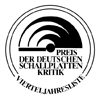 Ludwig van Beethoven
Ludwig van Beethoven